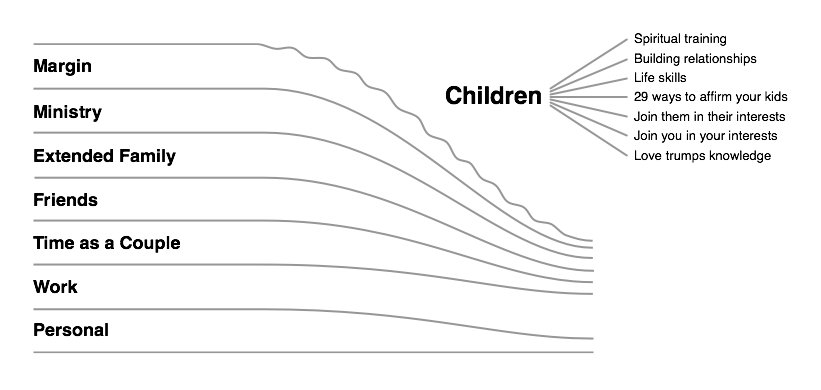What about our other time areas that get “squeezed” by our new family responsibilities? Let’s tackle them one by one.
Personal Time. To keep time for personal study or other interests, we may need a change in our daily schedule. As many parents have discovered, you may need to get up earlier to maintain your interest in reading or exercise. Also, including your kids in your hobbies and things you enjoy is a great family connection time.
Friends. We were created for community. We were created to enjoy the beauty of friendship. Naturally, with children in the house, there will be less time for softball with the guys or book clubs. But just as with our time as a couple, we do not want to let our friends time go to zero. Stay connected through a small group or Sunday School class at your church, or neighborhood picnics, or camping trips, or ministries like Mothers of Preschoolers.
Extended Family. With grandkids in the picture, your extended family and in-laws will probably want more of your time. One thing you need to keep in mind: you are the ones who define your family identity in terms of how you spend your time. Do not let other’s success agenda define your family. On the flip side, your extended family can be a great source of encouragement, community, and connectedness for you and your children.
Ministry. Your ministry opportunities do not need to go away while you are raising your family, but the focus is likely to change. It is natural to change to more child-focused service – AWANA, teaching Sunday School, etc. Also, never minimize your ministry to your family. As we will emphasize when we move to the “Children” part of the diagram, your family is your primary ministry!
Margin. Last on the list is margin, though it is usually the first to go in the time crunch. What do I mean by “margin”? On the printed page, margin is the space between the print and the edge of the page, and it is necessary to make reading pleasant. In life, margin is the space between our activity levels and our limits, and it is necessary to make family life pleasant. We all face limits in time, energy, and money. When we exceed these limits in our activities, responsibilities, etc., life suffers. In particular, the relational life that God intended suffers the most. (See the book Margin by Dr. Richard Swenson).
Besides the fact that no margin leads to burnout, there is another important reason we need margin in our lives. Margin equals availability to serve. Margin is not a spiritual necessity, but availability is. And because God’s commands are generally not schedulable, we must have some time availability to carry them out. Think about some of the things God has asked us to do. Go with someone the extra mile. Can we do this if we only have time for one mile? Or carry one another’s burdens. Or give witness to the truth at any opportunity. They all take availability. And preserving some margin in your family’s activities makes that happen.


